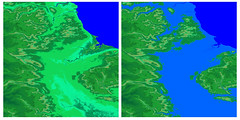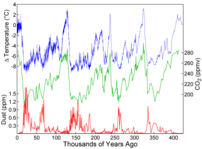
Image via Wikipedia
Lower Increases In Global Temperatures Could Lead To Greater Impacts Than Previously Thought, Study Finds
ScienceDaily (Mar. 1, 2009) — A new study by scientists updating some of the findings of the Intergovernmental Panel on Climate Change (IPCC) 2001 Third Assessment Report finds that even a lower level of increase in average global temperatures due to greenhouse gas emissions could cause significant problems in five key areas of global concern.
The study, published in theProceedings of the National Academy of Sciences, is titled "Assessing Dangerous Climate Change Through an Update of the IPCC 'Reasons for Concern."
In 2001, the IPCC published as part of its Third Assessment Report an illustrative figure which identified changes in climate authors determined to be "reasons for concern," and which could cause some or significant risks among five types of outcomes that could be categorized as "dangerous."
Sometimes referred to as the "burning embers" diagram, the five reasons for concern are:
- Risk to unique and threatened systems, such as the potential for increased damage to or irreversible loss of unique and threatened systems such as coral reefs, tropical glaciers, endangered species, unique ecosystems, biodiversity hotspots, small island states, and indigenous communities. The study authors contend that there is new and stronger evidence since 2001 of observed impacts of climate change on unique and vulnerable systems, with increasing levels of adverse impacts as temperatures increase further.
- Risk of extreme weather events, which tracks increases in extreme events with substantial consequences for societies and natural systems. Examples include increase in the frequency, intensity, or consequences of heat waves, floods, droughts, wildfires or tropical cyclones. The study authors point to new and stronger evidence of the likelihood and likely impacts of such changes, such as the IPCC Fourth Assessment Report conclusion that it is now "more likely than not" that human activity has contributed to observed increases in heat waves, intense precipitation events, and intensity of tropical cyclones.
- Distribution of impacts, which concern disparities of impacts, i.e. whether the poor are more vulnerable than the wealthy. Some regions, countries, and populations face greater harm from climate change while other regions, countries, or populations would be much less harmed - and some may benefit. The researchers find, for example, there is increased evidence that low-latitude and less-developed areas generally face greater risk than higher latitude and more developed countries and there will likely be disparate impacts even for different groups within developed countries.
- Aggregate damages, which covers comprehensive measures of impacts from climate change. Impacts distributed across the globe can be aggregated into a single metric such as monetary damages, lives affected, or lives lost. The study authors determine that it is likely there will be higher damages for increases in average global temperature then previously thought, and climate change over the next century will likely adversely impact hundreds of millions of people.
- Risks of large-scale discontinuities, which represent the likelihood that certain phenomena (sometimes called singularities or tipping points) would occur, any of which may be accompanied by very large impacts, such as the melting of major ice sheets. There is now better understanding that the risk of additional contributions to sea level rise from melting of both the Greenland and possibly Antarctic ice sheets may be larger than projected by ice sheet models assessed in the AR4, and that several meters of additional sea level rise could occur on century time scales.
The United Nations Framework Convention on Climate Change, which is in force and which the United States has ratified, calls for "stabilization of greenhouse gas concentrations in the atmosphere at a level that would prevent dangerous anthropogenic interference with the climate system." That level is not defined by the Convention nor has it been clearly defined in subsequent negotiations by parties to the Convention.
One of the authors, Michael Oppenheimer, a professor of geosciences and international affairs at Princeton University's Woodrow Wilson School, said, "The more we learn about the problem, the more severe the risk becomes and the nearer it looms. Cutting emissions of the greenhouse gases promptly is the surest way to reduce the risk, and that's how governments should be responding."
A lead author, Stephen H. Schneider, Stanford University professor of biology and interdisciplinary environmental studies and Senior Fellow at the Woods Institute for the Environment, said, "We need both mitigation and adaptation policies to cope with climate change, since we must adapt to changes we cannot prevent and mitigate changes that are hard to adapt to—that is, mitigation and adaptation are complements, not trade-offs"
Another lead author, Joel B. Smith, a Vice-President at Stratus Consulting in Boulder Colorado, said, "Based on observed impacts and new research, the risks from climate change in general now appear to be greater than they did a few years ago. The current path of greenhouse gas emissions is likely to lead to a change in climate that will exceed levels which we found will cause significant adverse impacts."
Other co-authors pf the study are Gary W. Yohe, William Hare, Michael D. Mastrandrea, Anand Patwardhan, Ian Burton, Jan Corfee-Morlot, Chris. H. D. Magadza, Hans-Martin Füssel, A. Barrie Pittock, Atiq Rahman, Avelino Suarez, and Jean-Pascal van Ypersele.
Journal reference:
- Joel B. Smith, Stephen H. Schneider, Michael Oppenheimer, Gary W. Yohe, William Hare, Michael D. Mastrandrea, Anand Patwardhan, Ian Burton, Jan Corfee-Morlot, Chris H. D. Magadza, Hans-Martin Füssel, A. Barrie Pittock, Atiq Rahman, Avelino Suarez, and Jean-Pascal van Ypersele. Assessing dangerous climate change through an update of the Intergovernmental Panel on Climate Change (IPCC) "reasons for concern". Proceedings of the National Academy of Sciences, 2009; DOI:10.1073/pnas.0812355106
![Reblog this post [with Zemanta]](http://img.zemanta.com/reblog_e.png?x-id=e15214ec-4d36-4bb6-be95-ad59c59f8ee0)


![Reblog this post [with Zemanta]](http://img.zemanta.com/reblog_e.png?x-id=8e75db0c-0389-4b3e-bb34-f8f92c02f915)

![Reblog this post [with Zemanta]](http://img.zemanta.com/reblog_e.png?x-id=40f39fbe-4f4a-46f5-a764-b9f70c1e75f6)